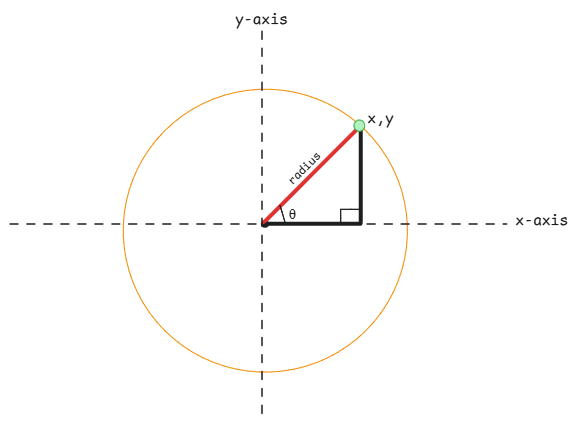Sine and Cosine
Sine and cosine are trigonometric periodic functions which relates to the unit circle.
It' is a branch of mathematics focused on the relationships between the angles and sides of triangles, particularly right triangles.
Trigon in Greek means triangle.
Polar to Cartesian Conversion
Cartesian conversion is the most common way of representing the co-ordinates using x and y axis. Whereas, Polar System uses the length of the radius and the angle from the x-axis to represent the position.
Trigonometry exactly provides a way to convert between these two co-ordinate systems.
x = r(cos(θ))
y = r(sin(θ))
All trigonometric functions are multiplied with the radius. This is because the sine and cosine functions assume 'unit circle', meaning a circle with radius 1.
Circumference - 2πR and this is 2π in case of unit circle.
This is also why all graphs show the x-axis with π or 2π as the time required for a full cycle.
Circle
This is the origin of the sine and cosine functions. Here the co-ordinates of the point rotating on the circumference of the circle represent the sine and cosine values.
- cosine - x co-ordinate of the point on the circle.
- sine - y co-ordinate of the point on the circle.
Radian is the length of the circular arc in a circle and one radian is equal to the length of the radius of the circle.

Triangle
Sine and cosine values can be calculated using the properties of a right triangle. Here the triangle can be placed inside a unit circle and the sine and cosine values can be calculated using the below formulas:
sine - opposite / hypotenuse
cosine - adjacent / hypotenuse
Opposite and adjacent values are relative to the angle θ and this angle depends on which of the two available angles is being considered.

Oscillations
It's just a coincidence that the oscillations such as swing, pendulum, and sound waves can be described using sine and cosine functions.
That's why physics uses these functions to describe the behavior of waves and oscillatory motion.
There is no real relation to circle or triangle here. The movement forms the same sinusoidal shape and hence it's used or referred to.
Inputs to Sine and Cosine Functions
Theta
Whenever sine and cosine functions are evaluated, the angle (often denoted as θ, or "theta") is the input. But this input variable not really used by the function.
It just denotes that the x and y variables are related to the angle θ in the unit circle. As the angle changes, the values of x and y co-ordinates which is nothing but the output of the cosine and sine functions also change.
Time
In the context of oscillations, time is often used as the input variable for sine and cosine functions. As time progresses, the angle θ changes, which in turn changes the values of the sine and cosine functions.
Even though the x-axis shows the co-ordinates of the moving point, in real life cases, it refers to time.
Frequency
Frequency refers to how fast the event completes one full cycle. In case of the object circulating the unit circle, the frequency is determined by how quickly the angle θ changes with respect to time.
- visualization[https://setosa.io/ev/sine-and-cosine/]
Sine and Cosine in Computation
Computers have no idea of angles or triangles. They only understand numbers and can compute the sine and cosine values using mathematical formulas.
So the libraries that build trigonometric functions use Taylor series formulae to calculate these values.